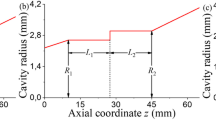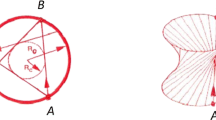Abstract
A new type of complex cavity structure is used to improve the selectivity of modes in gyrotron resonant cavity with a rational position of inter-cavity wall and the shape of coupling holes between inter- and outer-cavities. The resonant characteristics of the complex cavity operating in TE021/TE031 mode at Ka frequency band are simulated and analyzed with Ansoft HFSS code, which shows that mode competition can effectively be alleviated with the cavity structure and it may be useful to the formation of clustered-cavity for extending interaction frequency bandwidth.
Similar content being viewed by others
Reference
[1]. V. A. Flyagin et al, “The gyrotron”, IEEE Transactions on MTT, Vol. MTT-25, p514, 1977
[2]. V. L. Granatstein, B. Levush, B. G. Danly, and R. K. Park, “A Quarter Century of Research and Development”, IEEE Trans. Plasma Sci., Vol. 25, p1322, 1997
[3]. V. L. Granatstein and W. Lawson, “Gyro-Amplifier as Candidate RF Drivers for TeV Linear Colliders”, IEEE Trans. Plasma Sci., Vol. 24, p648, 1996
[4]. K. R. Chu and D. Dialetis, “Theory of harmonic gyrotron oscillator with slotted resonant structure”, Int. J. Infrared Millimeter Waves, Vol. 5, p37–56, 1984.
[5]. V. A. Flyagin and G. S. Nusinovich, “Gyrotron Oscillators”, Proceedings of the IEEE, Vol. 76, p644, 1988
[6]. Y. Carmel, K. R. Chu, M. Read, A. K. Ganguly, D. Dialetis, R. Seeley, J. S. Levine, V. L. Granatstein, “Realization of a Stable and Highly Efficient Gyrotron for Controlled Fusion Research”, Phys. Rev. Lett., Vol. 50, p112, 1983
[7]. A. W. Fliflet, R. C. Lee, M. E. Read, “Self-consistent field model for the complex cavity gyrotron”, Int. J. Electronics, Vol. 65, p273, 1988
[8]. O. Dumbrajs, E. Borie, “A complex cavity with mode conversion for gyrotron”, Int. J. Electronics, Vol. 65, p285, 1988
[9]. L. Jiang, “Theory for cylindrical, open ended, complex cavities supporting all TE0n modes: Gyrotron application”. IEE PROCEEDINGS_H, Vol. 138, p297, 1991
[10]. H. Guo, D. S. Wu, G. Liu, Y. H. Miao, S. Z. Qian, and W. Z. Qin, “Special Complex Open-cavity and low-magnetic-field high-power gyrotron”, IEEE Trans. Plasma Sci. Vol. 18, p326, 1990
[11]. Jirun Luo et al, “Design of a rotating mode filter”, 24th International conference on infrared and millimeter waves, TU-F5, Sept. 6–10, 1999, Monterey, California, USA
[12]. Ansoft HFSS User's Manu, Ansoft Corporation, 2002
Author information
Authors and Affiliations
Corresponding author
Rights and permissions
About this article
Cite this article
Luo, J., Guo, W. & Zhu, M. Numerical Simulation and Analysis of a New Type of Complex Cavity for Gyrotron Applications. Int J Infrared Milli Waves 26, 1703–1711 (2005). https://doi.org/10.1007/s10762-005-0291-6
Received:
Published:
Issue Date:
DOI: https://doi.org/10.1007/s10762-005-0291-6




